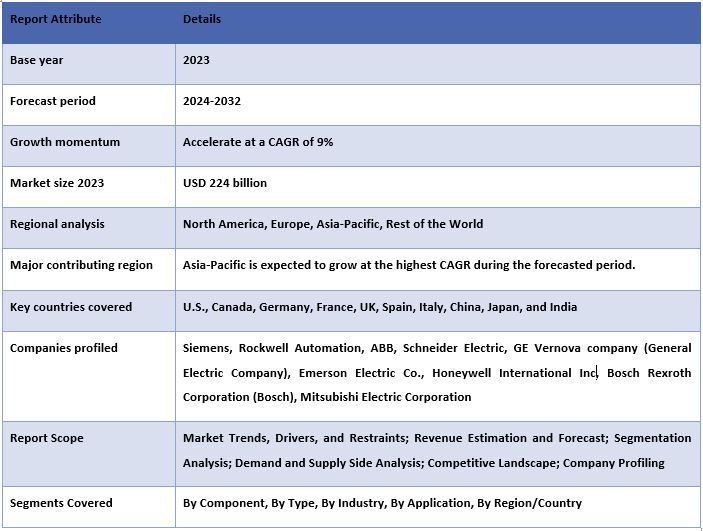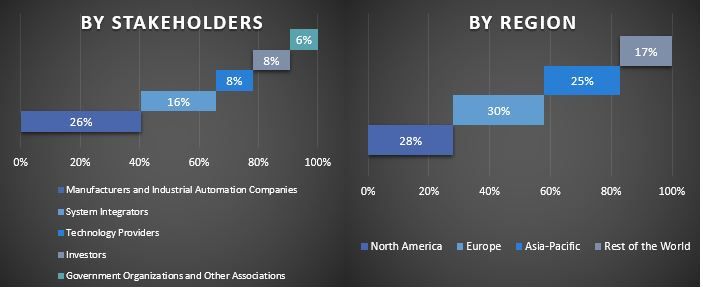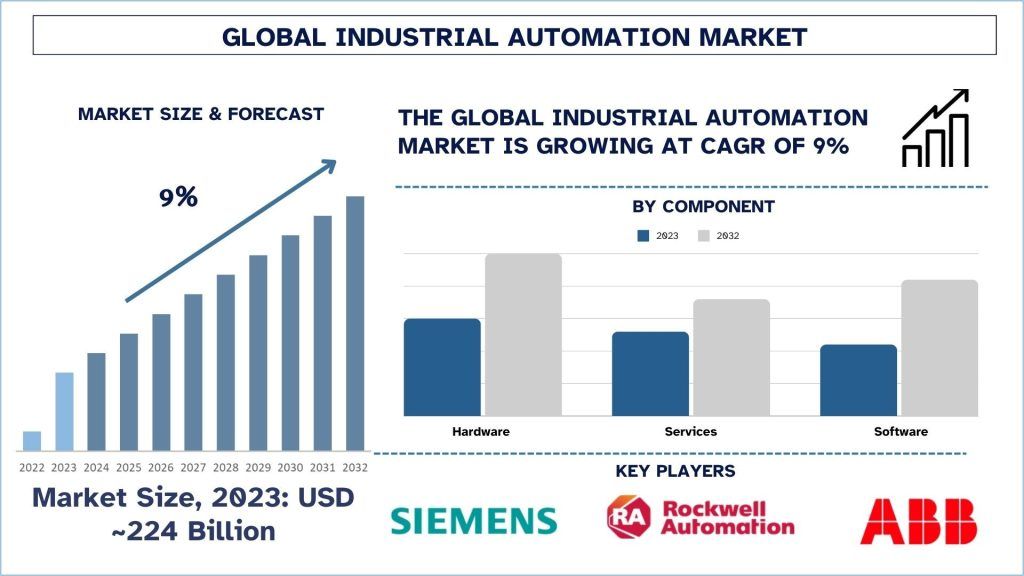- Home
- About Us
- Industry
- Services
- Reading
- Contact Us
Industrial Automation Market: Current Analysis and Forecast (2024-2032)
Emphasis on Component (Hardware, Services, Software), Type (Programmable Logic Controllers (PLC), Distributed Control Systems (DCS), Supervisory Control and Data Acquisition (SCADA), Human-Machine Interface (HMI), Industrial Robotics, Others); Industry (Automotive, Food & Beverages, Chemicals & Petrochemicals, Oil & Gas, Pharmaceuticals, Electronics & Semiconductor, Others); Application (Process Automation, Discrete Automation, Warehouse Automation); and Region/Country
Industrial Automation Market Size & Forecast
The Industrial Automation market was valued at approximately USD 224 billion in 2023 and is expected to grow at a substantial CAGR of around 9% during the forecast period (2024-2032) owing to the widespread adoption of Industry 4.0 pushing companies to digitize and automate manufacturing processes.
Industrial Automation Market Analysis
Industrial automation aims at the application of computer-based control systems for operating industrial facilities and processes through reduced human involvement. It improves the quality, speed, and safety of production as well as lessening the costs of production. With the help of the automated systems industries can manage processes, quality of their products, and even control the manufacturing process which will make it all faster and more accurate.
There, to achieve the targeted growth in industrial automation, several technologies including Artificial Intelligence Robotics, Internet of Things-based devices, and Cloud-based Automation Platforms are being deployed. These technologies lead to better decision-making, predicting equipment failures, and better flexibility on the production line. Also, companies launch collaborative robots (cobots) and edge computing to advance automation systems to enhance efficacy and integration across business processes.
In February 2024, OMRON Automation introduced TM S Series Collaborative Robots in its robotics portfolio in India. This latest addition to OMRON’s innovative lineup combines faster joints and expanded safety features, making it an ideal solution to improve the efficiency of factories in workspaces shared with people.
On October 18, 2023 – Schneider Electric, the leader in the digital transformation of energy management and automation, launched the Lexium Cobot, a collaborative machine featuring next-generation automation and advanced industrial robotics technology. The Lexium Cobot is designed to work closely alongside humans, performing uniquely gentle and diligent movements using dynamic torque and speed monitoring.
Industrial Automation Market Trends
This section discusses the key market trends influencing the various segments of the industrial automation market as identified by our research experts.
Programmable Logic Controllers (PLC) Transform Industrial Automation Industry
Programmable Logic Controllers (PLC) held a significant share of the market in 2023. PLCs are essential in automation because they regulate complicated processes in industries by periodically assessing and controlling them. They mainly contain flexibility, durability, and the capability to function in unfavorable conditions of manufacturing and oil industries. The increasing requirements for smart factories and high-level control systems have promoted the development of PLCs. Siemens, Rockwell Automation, and Mitsubishi Electric are the leaders in this market segment. In May 2023, Mitsubishi Electric Automation, Inc. expanded its line of MELSEC iQ-F series compact controllers to now offer a basic model providing OEMs with an all-in-one controller for small machines up to 60 I/O with integrated Ethernet connectivity. The FX5S PLC is a solution for simple automation applications at a more affordable price than the original FX5U high-performance model and FX5UJ mid-range model.

APAC has a significant share of the market in 2023.
The Asia-Pacific is currently a major contributor to growth in the industrial automation market and this is fueled by industrialization and urbanization taking place in countries like China, India, and Japan. Smart production systems characterized by advanced digitized solutions promoted by governmental policies and infrastructure investments boost efficiency and market sustainability. Moreover, a large industrial base in the region also requires the use of automation to improve efficiency and decrease expenses. Moreover, the growing middle class requires large quantities of consumer goods, for their production, so an efficient flow of operations is required.
On 25 July 2024, Cisco, a worldwide leader in networking and security, and Rockwell Automation, the world’s largest company dedicated to industrial automation and digital transformation, announced a collaboration to propel the digital transformation of the industrial market in the Asia Pacific, Japan and Greater China region. The announcement was made as the two companies signed a Memorandum of Understanding (MOU) on the same.

Industrial Automation Industry Overview
The Industrial Automation market is competitive, with several global and international players. The key players are adopting different growth strategies to enhance their market presence, such as partnerships, agreements, collaborations, new product launches, geographical expansions, and mergers and acquisitions. Some of the major players operating in the market are Siemens, Rockwell Automation, ABB, Schneider Electric, GE Vernova company (General Electric Company), Emerson Electric Co., Honeywell International Inc, Bosch Rexroth Corporation (Bosch), Mitsubishi Electric Corporation.
Industrial Automation Market News
- On 21 March 2024 – Siemens AG signed an agreement to acquire the industrial drive technology (IDT) business of ebm-papst. These systems are used in free-range driverless transport systems. The planned acquisition will complement the Siemens Xcelerator portfolio and strengthen Siemens’ position as a leading solutions provider for flexible production automation.
- On April 12, 2023 – Emerson (NYSE: EMR) and NI (Nasdaq: NATI) announced that they have entered into a definitive agreement under which Emerson will acquire NI for $60 per share in cash at an equity value of $8.2 billion. They provide enhanced automation capabilities and expansion into diverse, high-growth discrete end markets
- On August 31, 2023 — The Dürr Group completed the acquisition of automation specialist BBS Automation. The acquisition of BBS Automation is part of the expansion course Dürr is pursuing in the growth segment of automation technology.
Industrial Automation Market Report Coverage

Reasons to buy this report:
- The study includes market sizing and forecasting analysis validated by authenticated key industry experts.
- The report presents a quick review of overall industry performance at one glance.
- The report covers an in-depth analysis of prominent industry peers with a primary focus on key business financials, product portfolios, expansion strategies, and recent developments.
- Detailed examination of drivers, restraints, key trends, and opportunities prevailing in the industry.
- The study comprehensively covers the market across different segments.
- Deep dive regional level analysis of the industry.
Customization Options:
The global industrial Automation market can be customized further as per the requirement or any other market segment. Besides this, UMI understands that you may have your own business needs, hence feel free to connect with us to get a report that completely suits your requirements.
Table of Content
Research Methodology for the Industrial Automation Market Analysis (2022-2032)
Analyzing the historical market, estimating the current market, and forecasting the future market of the global Industrial Automation market were the three major steps undertaken to create and analyze the adoption of Industrial Automation in major regions globally. Exhaustive secondary research was conducted to collect the historical market numbers and estimate the current market size. Secondly, to validate these insights, numerous findings and assumptions were taken into consideration. Moreover, exhaustive primary interviews were also conducted, with industry experts across the value chain of the global Industrial Automation market. Post assumption and validation of market numbers through primary interviews, we employed a top-down/bottom-up approach to forecasting the complete market size. Thereafter, market breakdown and data triangulation methods were adopted to estimate and analyze the market size of segments and sub-segments of the industry. Detailed methodology is explained below:
Analysis of Historical Market Size
Step 1: In-Depth Study of Secondary Sources:
A detailed secondary study was conducted to obtain the historical market size of the Industrial Automation market through company internal sources such as annual reports & financial statements, performance presentations, press releases, etc., and external sources including journals, news & articles, government publications, competitor publications, sector reports, third-party database, and other credible publications.
Step 2: Market Segmentation:
After obtaining the historical market size of the Industrial Automation market, we conducted a detailed secondary analysis to gather historical market insights and share for different segments & sub-segments for major regions. Major segments are included in the report as component, type, industry, application, and regions. Further country-level analyses were conducted to evaluate the overall adoption of testing models in that region.
Step 3: Factor Analysis:
After acquiring the historical market size of different segments and sub-segments, we conducted a detailed factor analysis to estimate the current market size of the industrial automation market. Further, we conducted factor analysis using dependent and independent variables such as component, type, industry, application, and regions of the industrial automation market. A thorough analysis was conducted for demand and supply-side scenarios considering top partnerships, mergers and acquisitions, business expansion, and product launches in the industrial automation market sector across the globe.
Current Market Size Estimate & Forecast
Current Market Sizing: Based on actionable insights from the above 3 steps, we arrived at the current market size, key players in the global Industrial Automation market, and market shares of the segments. All the required percentage shares split and market breakdowns were determined using the above-mentioned secondary approach and were verified through primary interviews.
Estimation & Forecasting: For market estimation and forecast, weights were assigned to different factors including drivers & trends, restraints, and opportunities available for the stakeholders. After analyzing these factors, relevant forecasting techniques i.e., the top-down/bottom-up approach were applied to arrive at the market forecast for 2032 for different segments and sub-segments across the major markets globally. The research methodology adopted to estimate the market size encompasses:
- The industry’s market size, in terms of revenue (USD) and the adoption rate of the Industrial Automation market across the major markets domestically
- All percentage shares, splits, and breakdowns of market segments and sub-segments
- Key players in the global Industrial Automation market in terms of products offered. Also, the growth strategies adopted by these players to compete in the fast-growing market
Market Size and Share Validation
Primary Research: In-depth interviews were conducted with the Key Opinion Leaders (KOLs) including Top Level Executives (CXO/VPs, Sales Head, Marketing Head, Operational Head, Regional Head, Country Head, etc.) across major regions. Primary research findings were then summarized, and statistical analysis was performed to prove the stated hypothesis. Inputs from primary research were consolidated with secondary findings, hence turning information into actionable insights.
Split of Primary Participants in Different Regions

Market Engineering
The data triangulation technique was employed to complete the overall market estimation and to arrive at precise statistical numbers for each segment and sub-segment of the global industrial Automation market. Data was split into several segments and sub-segments after studying various parameters and trends in the component, type, industry, application, and regions of the global industrial Automation market.
The main objective of the Global Industrial Automation Market Study
The current & future market trends of the global industrial Automation market were pinpointed in the study. Investors can gain strategic insights to base their discretion for investments on the qualitative and quantitative analysis performed in the study. Current and future market trends determined the overall attractiveness of the market at a regional level, providing a platform for the industrial participant to exploit the untapped market to benefit from a first-mover advantage. Other quantitative goals of the studies include:
- Analyze the current and forecast market size of the industrial Automation market in terms of value (USD). Also, analyze the current and forecast market size of different segments and sub-segments.
- Segments in the study include areas of the component, type, industry, application, and regions.
- Define and analyze the regulatory framework for the industrial Automation
- Analyze the value chain involved with the presence of various intermediaries, along with analyzing customer and competitor behaviors of the industry.
- Analyze the current and forecast market size of the industrial Automation market for the major region.
- Major countries of regions studied in the report include Asia Pacific, Europe, North America, and the Rest of the World
- Company profiles of the industrial Automation market and the growth strategies adopted by the market players to sustain the fast-growing market.
- Deep dive regional level analysis of the industry
Frequently Asked Questions FAQs
Q1: What is the industrial Automation market's current size and growth potential?
Q2: What are the driving factors for the growth of the industrial Automation market?
Q3: Which segment has the largest share of the industrial Automation market by type?
Q4: What are the major trends in the industrial Automation market?
Q5: Which region will dominate the industrial Automation market?
Related Reports
Customers who bought this item also bought











